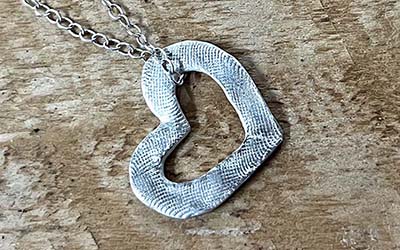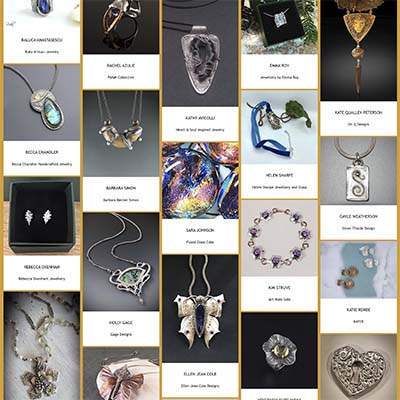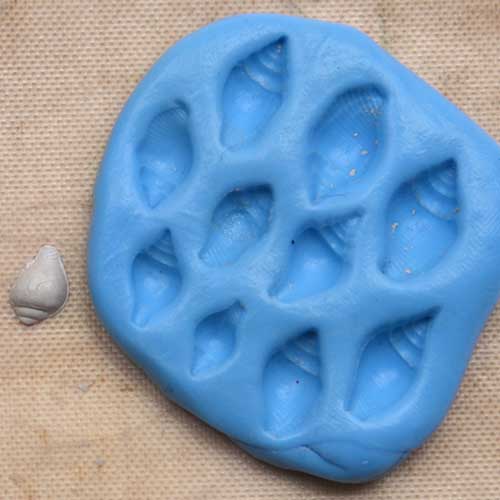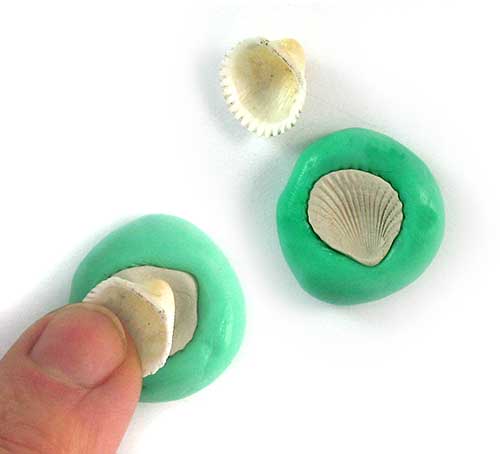Mold Making for Metal Clay
Why make molds?
As metal clay is a malleable material, it is ideally suited to be used for hand modelling all sorts of designs. It also picks up detail beautifully. That makes it perfect for reproducing a wide range of items, especially precious family heirlooms or fragile items that wouldn’t stand up to daily wear.
A key benefit of making molds is the ability to repeat something quickly and easily. It’s often an ambition of artists to make one-of-a-kind art that is totally unique, but sometimes you may want to make two identical items, like a pair of earrings. By using molds, even if it’s only for the base that you add embellishments to, you’re going to create a matching pair of earrings that are completely unique. You may have sculpted a piece from scratch that you would like to sell but been unable to reproduce it. If you make a mold of it, you have a base to start from which can be embellished to make it an individual and one-of-a-kind piece.
Also, if you’re creating a piece that has repeating components, it is much easier and faster to pop them out of a mold than to hand-sculpt each piece. If you’re selling your work, this is important as the most expensive part of the cost is your time. If you’re able to reduce the time spent on making a piece, it allows you to increase profit, which is important for the success and growth of your business.
Another useful technique is to make masters from an inexpensive material like polymer clay. It doesn’t have a set working time in the same way as metal clay does so it allows you to work on your design until you are completely happy with it. You can make as many prototypes as necessary and work out any snags in the design. When you’re happy with it, you can mold it and easily reproduce it in metal clay.
If you’re making matching sets like earrings and a pendant that use the same motif, you can use high shrinkage clay in the pendant mold to make the earrings. Once fired, the earrings will be proportionally smaller than the pendant. This also works well if you’re building a collection or making elements that will be soldered or used in traditional fabrication after firing. This allows you to have different sized elements to work with when designing.
Mold making materials
The most important characteristic of any mold making material is flexibility. This becomes even more important if the object being molded has any undercuts, even small ones. Without flexibility, it is nearly impossible to remove the dried clay from the mold without damaging the design. Even if you try to remove it before it’s completely dry, you still risk damaging the detail.
Different types are designed to have varying flexibility levels for different detail capture and are very versatile. One benefit of the two-part compound is the ability to decant a small amount of each part into pots that you can carry with you. This means you can mold things you find in everyday life and quickly create a mold to use later. The set-up time for the two-part silicone molding compounds varies by brand but is generally around five to 15 minutes.
This material is good for softer, more fragile items that you might not be able to press into a stiffer clay to create a mold. Place the item on a non-porous, flat surface, gently press the blended molding compound on top of the item and let gravity do the rest.
You can also make two-part molds using silicone molding compound so 3D items can be created. You need to use registration marks so the two parts fit together correctly. You will also need to use some form of barrier between the parts when you make the molds as the silicone compound sticks to itself.
Two part molding compound
You don’t need to use a release agent with metal clay, the molds are generally not prone to sticking.
The downsides of two-part silicone molding compound are:
- Some really fine details could be lost due to the consistency of the mix in the mold making material if you don’t blend it well.
- The flexibility can be a problem if the mold is too thin, causing distortion of the metal clay during use.
- If the ambient environmental temperature is very cold or very warm, the two-part silicone may not set up properly or may have an extended set up time.
- The set-up time can be an issue in that it is too short or too long, depending on the situation and the material.
Photopolymer plates that are used for printmaking are very good for creating low relief, flat designs. However, they are very labor-intensive, light-sensitive, and require special equipment to produce.
Thermoplastic pellets or bars make rigid molds. It comes in a rigid form but softens when heated – normally in hot water and can be used to mold items.
The plastic can be reheated and used over and over, making it attractive for items you don’t need a permanent mold of. An example might be making a copy of a lost earring so you can replace it.
They’re good for items you’re not sure will mold well; if the mold isn’t quite right, you just reheat the material and use it again.
The pellets are also good for porous materials that may not release well from a sticky silicone mold without damage to the original. You will need to use a release agent on this material.
Impressive Putty is another reusable mold making material. It requires a microwave to heat it to a malleable form. The reusable nature of it makes it ideal for use with molds that you may only need for a single item like the thermoplastic materials above.
The cured product is flexible which gives it an advantage over the thermoplastic pellets for some applications. And it works like a two-part silicone as it doesn’t require a separate release agent.
Technicalities of making molds
One of the things to consider when mold making is the depth of the object. If it is a low relief item, simply roll out a piece of molding material, press the object in, and leave it to cure. However, if your object is more three dimensional, for instance an acorn or pinecone, think about how you want the finished product to look. This might be a flat-backed charm with the shape of the object on one side for instance. Or maybe something that is going to be three dimensional. Knowing this before you start making your mold will greatly improve your success rate.
It is important that the mold us level, otherwise your design is likely to be distorted. This can result in extra finishing work after it’s dried. With metal clay though, mistakes with the depth and cleaning up edges are more easily corrected when the clay is dry. Even molds that are not quite perfect can still be useful. With practice at making and using molds you’ll find what works well for you.
There are several ways to make good molds of even the most odd-shaped items. For small items without significant differences in depth, simply press the item into a piece of RTV silicone at least twice as thick as the desired depth of the mold. If you have something that is very rounded or has a lot of variety in its thickness, you need to use more molding material. The high points are the areas where you risk the mold getting too thin.
If the back of the piece you’re molding is flat, lay it on a non-porous surface. Apply a ball of the mold-making material to the top of the item and press it out towards the edges to ensure no air is trapped. This also allows gravity to help the material get into all the recesses and means the top edge of the mold will be even.
Sometimes it’s useful to create a base for objects that don’t have a flat back or are rounded. A button that has a shank or something you only want a small part of are examples of this. Create a base using clay that the molding material will not stick to and embed the piece in this to isolate the part you want to mold. This method allows you to have a flat surface to mold against and an even edge around the piece. Keep in mind any deep undercuts will be problematic when removing your metal clay if the mold making material isn’t very flexible. The RTV silicones have different flex and stretch properties based on brand or type, so using the right flexibility for your mold is important.
Use the same shell to make the mold and press it into the back of the clay to get the shell imprint on both sides.
How to use a mold
Using single-sided molds is very similar to using texture sheets, except two-part silicone molds don’t need a release agent when using silver metal clay.
NOTE: Some of the base metal clays can be difficult to release from some of the softer, more flexible silicones. For these, use something like olive oil or a similar lightweight release agent. Thicker release agents like a balm can cause clogging which may distort the design. Applying it in a thin layer with a small brush can help prevent this if you want to use a balm type product.
If you’re using a polymer clay mold or a rubber-based mold, you will need to use a release agent. The same information applies to these, keep the release agent thin so it doesn’t cause any distortion of the design.
For molds that are deeper, roll your clay into a teardrop shape making sure there are no cracks or folds on the pointed end. Press the point into the center of the mold. Use your thumb or a large ball tool to ensure the clay is evenly distributed into the mold. Estimating how much clay to use in the mold can require a bit of trial and error until you have more experience. Using too much clay can result in uneven edges in the dry piece and additional work to remove the excess clay. If the quantity isn’t quite right, just remove the metal clay from the mold, adjust the amount and try again.
If you have too little to fill the whole surface of the mold, adding to it can create a line in your finished piece so it’s better to start again. If you have the surface of the mold covered and only need to add thickness, you can generally add another layer of clay with no issue.
You don’t have to fill the mold or use the whole molded design when making your metal clay piece. You may want to mold parts of things or purposefully use too little clay to create uneven edges. You can also use clay that is a slightly dried out so it cracks a little, creating an aged, worn look. These are a few ways to create unique and one-of-a-kind pieces from molds so experiment to get the result you want.
For large or flat molds, it may be easier to start with a thick slab of metal clay and use a soft rubber-tipped or rounded tool to press the clay into the mold. As with the rounder pieces, start in the middle and work outwards. This keeps air bubbles from getting trapped in the mold and causing voids in your design.
Once the clay is in the mold, be patient. If you remove the metal clay from the mold before it is dry, you must be careful not to damage the impression. If you have the time, allowing the clay to dry in the mold will yield the best results. You can expedite the drying by placing the mold on a drying plate for instance a mug warmer or small griddle. Most RTV materials can support temperatures up to 250˚F (121˚C). Higher temperatures can cause the mold to become hard, lose its non-stick or flex capabilities, or even melt, depending on the brand.
Polymer clay can be over-baked so be careful is you want to speed up the drying, especially on a hot plate. Dehydration is the safest route but can take longer if your mold is deep. For some of these alternative mold materials, it’s best to leave them to air dry for a few days to ensure the metal clay can be safely removed.
When placing the mold on the warmer, place it with the clay down against the warm surface. This allows the clay to get the heat faster and helps the piece to release from the mold more quickly.
Once the back is really firm it’s usually safe to pull the clay out gently. Often the clay will just drop out of the mold. For flexible molds with undercuts, it’s best to leave the piece in the mold until it is mostly dry.
Doing finishing work before the entire piece is dry can also cause problems. If your piece is still damp in the center when you start filing on the edges, the piece could suffer major distortion. Always do the mirror test to detect any residual moisture by placing the cooled piece on a clean mirror for five seconds. When you remove it, if there is moisture on the mirror, the piece is not dry. Place back on the warmer to fully dry.













